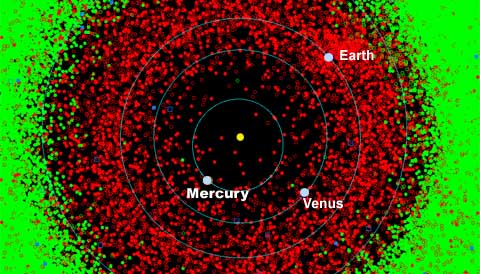Astronomy - Near-Earth Asteroid Tally Reaches 15,000
Thanks to two aggressive search programs, the count of near-Earth asteroids has soared past the 15,000-object milestone.
On August 13, 1898, Carl Gustav Witt discovered a medium-size asteroid that circled the Sun much closer than its siblings did. In fact, what came to be called 433 Eros actually crosses the orbit of Mars during its 1.8-year solar circuit, and it can come as close to the Sun as 1.13 astronomical units (170 million kilometers).

A plot of all known near-Earth asteroids (NEAs, shown in red) looks scary, but the risk of collision is actually quite low. Main-belt asteroids are shown in green.
Minor Planet Center
Minor Planet Center
From that modest beginning, the hunt for near-Earth asteroids (NEAs) — those that venture within 1.3 a.u. of the Sun — has evolved from sporadic, inadvertent pickups to dedicated searches that net hundreds of new objects every month.
A week ago, the International Astronomical Union's Minor Planet Center (just a few blocks from Sky & Telescope's offices) announced the discovery of asteroid 2016 TB57. With that find, the MPC's catalog of all known NEAs reached a new threshold: 15,000.

The 15,000th cataloged near-Earth asteroid is a small space rock designated 2016 TB57. It skirted near Earth on October 31, 2016, 18 days after its discovery.
NASA / JPL
NASA / JPL
Much like the steady climb of the stock market with time, there's no particular significance to a count of 15,000 (it's already zoomed to 15,197 as I write this) or to 2016 TB57. Observers participating in the NASA-funded Catalina Sky Survey discovered it on October 13th as it neared Earth. Rather small, roughly 15 to 35 m across, it passed by at a very safe distance of 2,010,000 km (more than five times the Moon's distance) on October 31st.
Most NEAs are found, as their name implies, someplace near Earth. Generally they're too small to be spotted far away, and it's only within the week or so when they skim near our planet that they make their existence know. These days almost all NEAs are swept up by the Catalina survey or by Pan-STARRS 1, a wide-field telescope on Haleakala in Hawai'i. (That name is a contraction of Panoramic Survey Telescope & Rapid Response System.)
Dynamicists break down NEAs into four types, each named for an archetype asteroid in that class. Amors (like Eros) cross the orbit of Mars but come no closer than 1.017 a.u. to the Sun (Earth's aphelion distance). Apollos have semimajor axes (their mean heliocentric distance) greater than 1.0 a.u. but still cross Earth's orbit at their closest. Atens have semimajor axes of less than 1 a.u. but likewise cross Earth's orbit (our planet's perihelion distance is 0.983 a.u.). At its most recent count, the MPC had tallied 6,537 Amors, 7,449 Apollos, and 1,120 Atens.

The pace of discovery for near-Earth asteroids has increased rapidly in recent year. Most of the recent ones are small.
NASA / JPL
NASA / JPL
Apohele asteroids (sometimes called Atiras) are the newest and smallest group — only a dozen or so have been confirmed — and their entire orbits lie entirely inside of Earth's.
With all those space rocks flying around, you'd think that Earth might be in grave and imminent danger of a collision. But space is a big place, and neither NASA's Near-Earth Object Program nor its European Space Agency counterpart lists any object with a cumulative probability (that is, the risk over dozens of close approaches) higher than about 1 in 1,000. And that object is 2011 AM37, though no individual close pass at Earth has an impact risk greater than about 1 in 15,000.

NASA's NEAR-Shoemaker spacecraft recorded this view of its final destination, asteroid 433 Eros, on February 12, 2000.
NASA / JHU-APL
NASA / JHU-APL
Besides, it's only about 4 m (15 feet) across — almost certainly too small make it through our atmosphere to the ground.
Meanwhile, 433 Eros has hardly been relegated to the back shelf of asteroid discoveries. A highly elongated body about 34 km long, Eros played host to NASA's NEAR-Shoemaker spacecraft, which orbited it for a year in 2000–01. Then, on February 12, 2001, the spacecraft made a dramatic — but mission-ending — landing on Eros' surface.
No comments:
Post a Comment